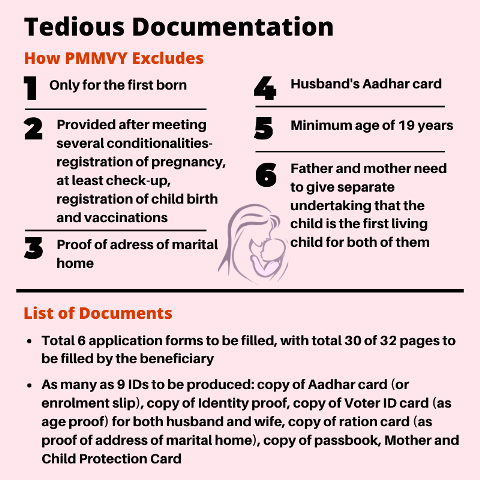Pradhan Mantri Matru Vandana Yojana
- 20 Dec 2019
- Recently, concerns have been raised over the Pradhan Mantri Matru Vandana Yojana (PMMVY) for its exclusionary nature. The scheme suffers from critical drawbacks in both design and implementation.
Underlying Issues with PMMVY
Lengthy Documentation
- The lengthy documentation work includes filling up six documents totaling 32 pages - an application form to be filled for each of the three installments, an application for linking the Aadhaar card with bank account, another one for linking the Aadhaar card with post office account and a feedback form.
- This tedious process led to exclusion of single women and young brides out of its purview.
- Further, the documentation work is likely to result in many women living on the margins, such as sex workers, women in custody, migrant and those living in post-conflict situations unable to claim benefits even though they are most in need of monetary compensation.
First Child Criteria
- The gaping loophole in the eligibility criteria is that benefits are only provided for the birth of the first child.
- In a country with a Total Fertility Rate (TFR) of 2.33, the policy of restricting the scheme to just the first child is impractical to say the least and exclusionary when seen in totality.
- Moreover, it makes no attempt to accommodate miscarriage or infant mortality. If an eight-month pregnant woman, who has already accessed the scheme, loses her child, she is not eligible for the second or third instalment for her next pregnancy.
Issues with Single Women
- Registration for the scheme requires the beneficiary to provide her husband’s Aadhaar details along with her own, affecting single women which include unwed mothers, deserted wives and widows.
Newly Wed Women
- A newly wed woman expecting a child generally resides in her maternal home but to avail the benefits of PMMVY, she needs to provide proof of address of her marital home, whichagain proves a major challenge for her.
Younger Brides
- The scheme require that the applicant has to be at least 19 years old also leaves out younger brides, who hesitate in getting their marriages registered as the legal age of marriage is 18 years.
- 30-35% first-time mothers are under the age of 18 years.
Corruption Issues
- The scheme is infested with corruption issues, limiting its scope of proper implementation. The applicant women have to pay a hefty bribe during the application process at every level, which goes up to Rs. 500, with each of the three forms.

Pradhan Mantri Matru Vandana Yojana (PMMVY)
Objective
Target Beneficiaries
Implementation
|
Inclusive Measures
- Firstly, activists and grassroot workers involved must make a formal representation to the government, highlighting their concerns in order to make the scheme both inclusive and supportive.
- Secondly, the government needs to review the scheme in order to make it universal by removing restrictions on the number of children as well as including all women, whether they are in the formal or informal sector, engaged in paid or unpaid wor
- Thirdly, the sum promised should also be at least on par with minimum wages for women in self-employment, unpaid work, or working for less than minimum wages.
States Maternity SchemeTwo states- Tamil Nadu and Odisha, have not implemented the centrally sponsored scheme and has launched their own maternity schemes. Dr. Muthulakshmi Reddy Maternity Benefit Scheme- Tamil Nadu
|




